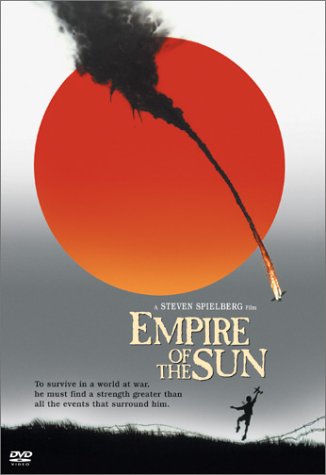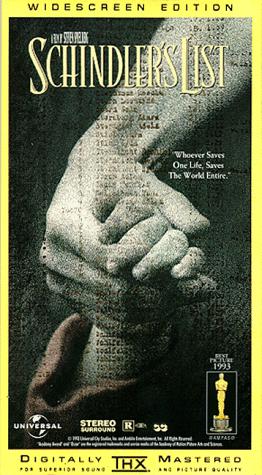 :
Study
Questions: Week Five
:
Study
Questions: Week Five :
Study
Questions: Week Five
:
Study
Questions: Week Five
World War II and the Holocaust.
The Empire of the Sun (1987)
Schindler's List (1993)
 1.
The Empire of the Sun is Steven Spielberg's first film set in World War
II. Why, in your opinion, does he choose to view events through the eyes of
an adolescent boy?
1.
The Empire of the Sun is Steven Spielberg's first film set in World War
II. Why, in your opinion, does he choose to view events through the eyes of
an adolescent boy?
2. Why does the film begin at an Anglican church service? What does it reveal about Jim's (Christian Bale) pre-war life? What does it also say about class differences and racial attitudes?
3. How do the images in the opening sequences (Jim plays with models, encounters a servant in the kitchen, sees tables and refrigerators filled with food) foreshadow the events to come?
4. One of the most important moments in the film occurs when Jim is separated form his parents. How does this event mark the beginning of his physical and spiritual journey? What is the nature of this journey, and why does it involve losing mother and father? How might Jim's journey be compared to Celie's in The Color Purple? Or to the little girl in the red coat in Schindler's List?
5. In what way is Basie (John Malkovich) a guide for Jim's journey? Remember he is described as a "conjurer" who works "underground." Does he seem to have magical powers? When does Basie appear? When do we last see him? Why must Jim reject him in the end?
6. Dr. Rawlins (Nigel Havers) refers to Jim as a pragmatist. Why does he do so? Why does Basie describe the term as "a good word"? How does Jim's pragmatism allow him to survive while many of the tradition-bound British (i.e. the Victors) perish? How might his pragmatism prompt Basie to call him "an American now"?
7. What accounts for Jim's obsession with airplanes? Why does he respect both the Japanese and the American airmen? How does the death of the boy pilot who befriends him comment on the Basie's ethic of personal survival?
8. How does Mrs. Victor (Miranda Richardson) help define Jim's coming of age? What is the significance of his turning away from the spectacle of the air raid to watch the Victors in bed?
9. What is the irony of Jim's momentary belief that he sees Mrs. Victor's soul ascending into heaven? How does the discovery that he has seen an atomic bomb exploding across the Chins Sea in Japan mark the end of his innocence? Think of airplanes and the previous question
10. The Empire of the Sun has been criticized for reducing the War to a coming-of age-story. Do you agree? Why? Why not? In what ways might it be regarded as autobiographical, a film marking Spielberg's development as a serious film maker? Consider his films of the 1990s.
11. What is the significance of the prologue to Schindler's List which opens in color and cuts from the extinguished candle to the train to Auschwitz?
12. Why are the first images of the impending Holocaust devoted to images of bureaucracy: papers, lists of people, pens, ink, etc.? In what way might they be seen as more sinister and heartless than familiar images of guards beating prisoners?
13. Consider the first half hour of the film. How does Spielberg use the elegant editing of visual images rather than dialogue to establish the film's plot and, more important, make very clear the fate of Poland's Jews? Give a few specific examples of Spielberg's method.
14. How does the destruction of the Jewish community and family life parallel the opening of The Empire of the Sun? What other of Spielberg's films open with events which show a similar disruption of a world which protects children?
15. In what ways are Schindler's (Liam Neeson) values and ambitions at odds with his decision to save his workers?
16. Why does Spielberg focus on the life and death of the one-armed worker (the first on-screen death). How does his death serve as a metaphor for the Holocaust itself?
17. The arrival of Amon Goeth (Ralph Fiennes) marks the beginning of the true horror. How is he similar to the depiction of Nazis and prison camp commanders in other films? How does Spielberg modify the stereotype to make Goeth more "realistic" and more sinister?
18. In what ways might Itzhak Stern (Ben Kingsley) be seen as another example of Spielberg's admirable pragmatists?
19. What is the thematic and moral significance of the sequence which crosscuts between images of the opulent nightclub party with Schindler and senior Nazi officers and images of Goeth attacking his maid in the wine cellar?
20. What do you make of the concluding sequence, which echoes the opening scene of names being read from a list? What is the difference between the two lists? What is the significance of the contrasting images of Schindler's people being saved and so many more heating to the gas chambers? How are we to interpret this conclusion? Why did Spielberg add the final scene in color of survivors in Israel?